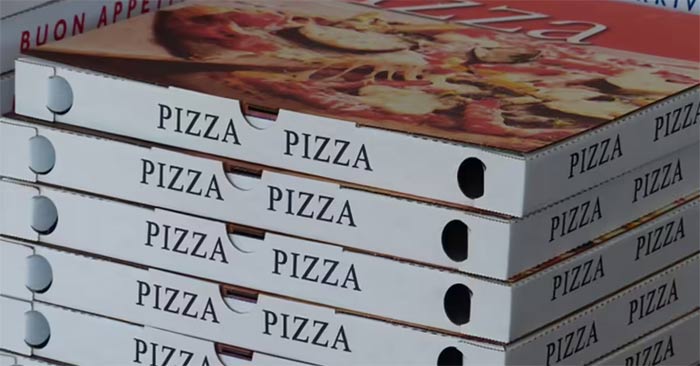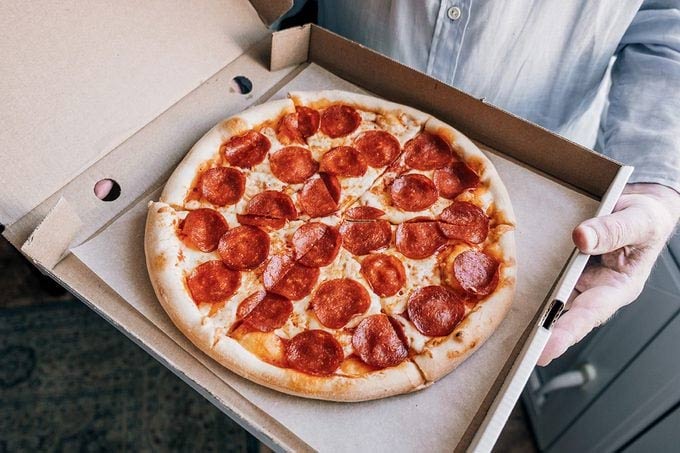What is the hole in the pizza box for?
Those little holes on pizza boxes are more important than many people think. Here's what those little holes on pizza boxes actually do .

When we buy take-out or delivery pizza, the box has holes in it, even though we want the pizza to stay hot all the way home. So what do those holes really mean and where do they come from?
Essentially, these holes ensure that the pizza arrives at its destination in the best possible condition, almost as if it were taken out of the oven. Here's how the holes make that magic happen.
Let the steam out
This is where the holes in the sides of the pizza box come in. ' A hot pizza continues to give off steam even after it comes out of the oven ,' explains Gregorio Fierro, a senior instructor at Scuola Italiana Pizzaioli and owner and president of restaurant consulting firm Conspersa Enterprises. ' If you put the pizza back in the box as soon as you take it out, the steam will be trapped in the box and make the pizza soggy .' The result is a pizza that sags as soon as you pick it up, sending all the delicious cheese and toppings spilling onto the floor. Not what diners want.
Experts recommend pizzerias leave pizzas on a strainer for a few minutes before packing them, but even then, restaurants should still open the vents to let steam escape and maintain crispness, Fierro added.
Keep pizza warm
Pizza makers don't want their pizza to lose its firmness or crispness, but they also don't want it to cool before it's ready to eat. That's why the holes are small and on the sides of the box, rather than large and on the top. This circular design traps enough heat from the pizza to keep it warm, but the holes allow a little steam to escape to maintain the texture.

When did pizza shops start using boxes like this?
' The current box style is often attributed to Tom Monaghan, founder of Domino's Pizza, who was looking for a sturdier way to deliver a stack of pizzas at a time ,' Fierro says. ' He teamed up with a paper company, Triad, to create what became known as the Michigan box .' The original design, developed in the 1960s, had no vent holes on the sides. ' The vent holes were actually hand-cut by some experienced pizza makers if they knew the pizzas were being shipped,' Fierro explains. 'Nowadays, most vent holes are punched at the factory .'
Before the corrugated, folding pizza box we know and love today, people had a variety of ways to deliver pizza. 'In Naples, Italy, where pizza originated, there was a drum-shaped device called a stufa that was carried by traveling vendors that allowed pizza to be eaten outside the store, ' says Fierro. ' The original delivery system in the United States was a bit more rudimentary. Pizza was rolled up and wrapped in paper. A lot of pizza was also sold in paper bags. In fact, there are still some parts of the country that sell pizza sliced into paper bags .'
Believe it or not, pizza didn't start being packaged and delivered in boxes like we do today until after World War II, when its popularity really exploded. 'People started experimenting with larger versions of the regular cardboard pizza boxes,' adds Fierro. 'It was definitely better than a bag, but it didn't help the pizza travel undamaged and stay warm .'
Then, in the 60s, Domino's started using the Michigan box and the rest is history. ' Sixty years later, this is more or less the box design that most pizza companies still use today ,' host Zachary Crockett said in a 2023 episode of The Economics of Everyday Things podcast about pizza boxes.
Do all pizza boxes have holes?
Yes and no. ' At this point, most boxes have perforated cutouts, but they need to be pushed open by hand, ' Fierro says. This may relate to another important consideration in pizza box design: the structural integrity of the box.
If the holes were punched completely or were larger than the actual size, there would be a risk of the boxes falling onto the pizza if multiple boxes were stacked on top of each other. That's something the original designer had in mind and is why this design exists.
Do some pizzas taste better in boxes without holes?
In short, no. Whether you order New York-style, Chicago-style, Detroit-style, Sicilian-style, or Greek-style pizza, you'll find holes in the box. "Most boxes, despite their size, have similar characteristics," says Fierro. Indeed, even if pizza isn't designed to be crispy, you still want a crust that's firm and not soggy for easier, more enjoyable eating—and a pizza box with holes is the best way to achieve that delicious flavor.
You should read it
- Eating burgers and pizzas increases the risk of recurrence of multiple sclerosis in young children
- With paper, pizza, olive nuts and bottle caps, you can still fool Face ID on iPhone X
- 10 simple ideas but most of us do wrong
- How to Fix a Frozen Mac
- How to Store Fresh Yeast
- 24 extremely interesting facts you may not know yet
 What you need to know about the new blood type: Gwada negative
What you need to know about the new blood type: Gwada negative What is the round hole on a safety pin used for?
What is the round hole on a safety pin used for? What are the little dots on the apple?
What are the little dots on the apple? The world's unique church wonder, built for 140 years and still not finished, is stunningly magnificent
The world's unique church wonder, built for 140 years and still not finished, is stunningly magnificent Analyzing How Kabbalah Numerology Works
Analyzing How Kabbalah Numerology Works Love Compatibility According to Numerology: Meaning of the Levels
Love Compatibility According to Numerology: Meaning of the Levels